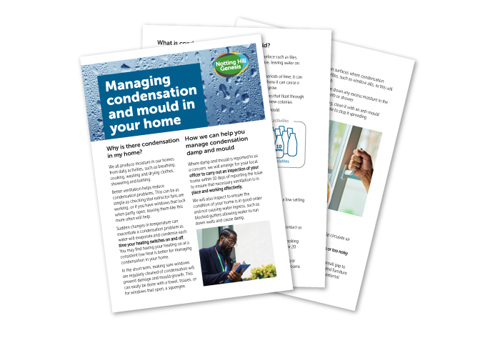Experts agree that with proper ventilation, insulation and heating, condensation can be avoided or reduced. Here are some tips on how to do this.
Why is there condensation in my home?
We all produce moisture in our homes from daily activities, such as breathing, cooking, washing and drying clothes, showering and bathing.
Better ventilation helps reduce condensation problems. This can be as simple as checking that extractor fans are working, or if you have windows that lock when partly open, leaving them like this more often will help.
Sudden changes in temperature can exacerbate a condensation problem as water will evaporate and condense each time your heating switches on and off. You may find having your heating on at a consistent low heat is better for managing condensation in your home.
In the short term, making sure windows are regularly cleaned of condensation will prevent damage and mould growth. This can easily be done with a towel, tissues, or for windows that open, a squeegee.
How we can help you manage condensation damp and mould
Where damp and mould is reported to us a concern, we will arrange for your local officer to carry out an inspection of your home within 10 days of reporting the issue to ensure that necessary ventilation is in place and working effectively.
We will also inspect to ensure the condition of your home is in good order and not causing water ingress, such as blocked gutters allowing water to run down walls and cause damp.
What is condensation damp and mould?
Condensation occurs when warm, moist air touches a cooler surface such as tiles, windows or walls. This causes the moisture in the air to condense, leaving water on these surfaces.
If condensation is allowed to sit on walls and windows for long periods of time, it can penetrate the outer layers of your walls and seep into furniture where it can cause a longer term problem by allowing damp and encourage mould to grow.
This mould can then spread as it reproduces by releasing tiny spores that float through the air. When these spores settle on wet moist surfaces, they form new colonies.
A warm, properly ventilated home can prevent condensation and mould.
Managing condensation
You can also download the 'Managing condensation and mould leaflet' for more information.
Set your thermostat to 18–21°C. Keep your heating on a low setting at all times so your home doesn’t get too cold.
- Check your extractor fan is working correctly, if not contact us for a repair
- Open a window or use an extractor fan when you’re cooking or bathing. Leave windows open or fans switched on for 20 minutes afterwards.
- Close kitchen and bathroom doors when you’re cooking or bathing. This will stop condensation from spreading to other rooms.
- Every day, wipe down surfaces where condensation forms or moisture settles, such as window sills, as this will prevent mould growth.
- Use a squeegee to wipe down any excess moisture in the bathroom after every bath or shower.
- If you see mould growing, clean it with an anti-mould cleaner as soon as possible to stop it from spreading.
- Dry clothes outside if possible. If you can’t, dry them in a cooler room with a window open and the door closed.
- If you use a tumble dryer, either use the condensing type or ensure the exhaust vent is properly installed – don’t just hang it out of a window.
- Try not to use radiators to dry clothes. This stops them from working properly which can lead to a colder home and higher heating costs.
- Don’t cover air bricks or ventilation holes in your property, these help circulate air and reduce condensation.
- Don’t switch off or block extractor fans. If your extractor fan is broken or too noisy please contact us so we can repair or replace it.
- Avoid putting furniture or other items directly against the wall. Leave a small gap to allow airflow. If you have a condensation problem, mould can form behind furniture or other items pushed against the wall. Try not to place furniture against external walls
Do you need more help?
Following the tips above can help you avoid condensation in your home, but we do realise that not all damp and mould issues can be tackled by residents.
If you have a problem with condensation or mould in your home that you cannot manage, you can now call our dedicated telephone line 020 8451 8001. Alternatively, contact your housing officer/property management officer via My Account.
A warm home can reduce condensation. If you have concerns about the heating in your home you can find help and advice on our cost of living support page.
Unresolved leaks can lead to mould appearing in your home and can lead to severe damage. Please tell us as soon as possible if you see signs of a leak. We can arrange for a contractor to attend as a priority or send a surveyor if a more detailed investigation is needed.

